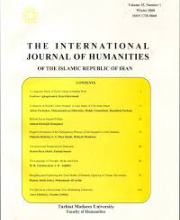Some Cognitive Insights into Perspectivization in Persian Narratives(مقاله علمی وزارت علوم)
Perspective is one of the factors involved in the diversification of schema. The viewpoint from which one looks at a scene somehow affects the process of semantic representation of that scene. Every sentence has its special schema drawn upon the scene in question, and adopting different points of view towards the same event will result in the speakers’ choosing different linguistic structures to express the event. Therefore, perspective is one of the most salient structure-formation processes that has received much attention from cognitive linguists. Cognitivists interested in linguistic impacts of perspective, following Langacker (), have laid their study on the assumption that the relative status and the angle of vision influence what language is used in describing certain situations. However, the question in this regard is whether or not the two parameters meet the adequacy required both for describing and for explaining different scenes linguistically. The answer seems to be that the specific perspective taken by the speaker is itself very much based on some further elements as animacy, dynamicity, size, and speaker. Present article is therefore written in order to question the problem of perspective, and the elements that are likely to bear upon its linguistic representation in Persian. Furthermore, it will also be taken into question if, according to what cognitive linguists argue for, there is such a universal cognitional framework common to all the human beings. For this purpose, a body of Persian written and spoken data, gathered from narrative dialogues and everyday talks, is to be examined inductively. Although this is an unprecedented study on some fundamental cognitive-semantic issues, the results would pretty hopefully apply in much more detailed semantic analyses of sentence perspective as well.
